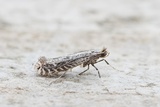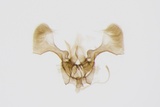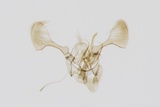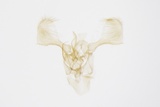Parornix finitimella (Zeller, 1850) Species
Last modified: Dec. 14, 2024, 3:09 p.m.
A rare species throughout Belgium.
Details
- Classification
- Family: Gracillariidae > Subfamily: Gracillariinae > Tribus: Parornichini > Genus: Parornix > Species: Parornix finitimella
- Vernacular names
- Sleedoornzebramot (NL), Pointed slender (EN), Kleine Schlehen-Randfaltenmotte (DE)
- First mention in Belgium
- De Fré Ch. 1858. Catalogue des Microlépidoptères de la Belgique. — Annales de la Société entomologique belge 2: 45–162. On page 147. view page
- Status
-
Native
Distribution
Caterpillar
Greenish yellow, head light brown. Legs black (in Parornix torquillella legs are yellowish green to pale brown). Prothoracic segment with four dark brown spots of which the two inner ones are much larger than the two outer ones (Parornix torquillella, also living on Prunus spinosa has only two such spots (often diffuse); but this character seems to be very variable, so be careful with identification.)
Mine
The first instar lives in a narrow gallery on the underside of the leaf. Later on, this gallery is widened into a blotch, and after applying some silk, it turns into a small, but strongly inflated, tentiform mine, situated between two veins. Because all the leaf tissue is consumed, the mine turns whitish.
Bionomics
The free-living instars fold a leaf margin downwards and fasten it with some whitish silken threads. They continue feeding within this fold. At least two such folds are constructed.
Pupation inside the fold, with the fallen leaf between leaf litter on the ground. The species hibernates in the pupal stage.
Adults rest during the day between the foliage. They become active towards dusk and at night. They come to light.
Flight periods
Two generations a year June–July and August till mid-October.
Observed on
- Host plant (species):
- Prunus spinosa
The species primarily lives on Prunus spinosa, but occasionally also accepts other Prunus species, like Prunus avium, P. cerasifera, P. domestica, P. mahaleb and P. padus.
Habitat
Hedge rows, road sides, parks and gardens where Prunus spinosa is planted.




